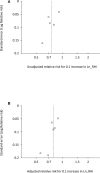Prognostic Value of Flow-Mediated Vasodilation in Brachial Artery and Fingertip Artery for Cardiovascular Events: A Systematic Review and Meta-Analysis
- PMID: 26567372
- PMCID: PMC4845238
- DOI: 10.1161/JAHA.115.002270
Prognostic Value of Flow-Mediated Vasodilation in Brachial Artery and Fingertip Artery for Cardiovascular Events: A Systematic Review and Meta-Analysis
Abstract
Background: Endothelial dysfunction plays a pivotal role in cardiovascular disease progression, and is associated with adverse events. The purpose of this systematic review and meta-analysis was to investigate the prognostic magnitude of noninvasive peripheral endothelial function tests, brachial artery flow-mediated dilation (FMD), and reactive hyperemia--peripheral arterial tonometry (RH-PAT) for future cardiovascular events.
Methods and results: Databases of MEDLINE, EMBASE, and the Cochrane Library were systematically searched. Clinical studies reporting the predictive value of FMD or RH-PAT for cardiovascular events were identified. Two authors selected studies and extracted data independently. Pooled effects were calculated as risk ratio (RR) for continuous value of FMD and natural logarithm of RH-PAT index (Ln_RHI) using random-effects models. Thirty-five FMD studies of 17 280 participants and 6 RH-PAT studies of 1602 participants were included in the meta-analysis. Both endothelial function tests significantly predicted cardiovascular events (adjusted relative risk [95% CI]: 1% increase in FMD 0.88 [0.84-0.91], P<0.001, 0.1 increase in Ln_RHI 0.79 [0.71-0.87], P<0.001). There was significant heterogeneity in the magnitude of the association across studies. The magnitude of the prognostic value in cardiovascular disease subjects was comparable between these 2 methods; a 1 SD worsening in endothelial function was associated with doubled cardiovascular risk.
Conclusions: Noninvasive peripheral endothelial function tests, FMD and RH-PAT, significantly predicted cardiovascular events, with similar prognostic magnitude. Further research is required to determine whether the prognostic values of these 2 methods are independent of each other and whether an endothelial function-guided strategy can provide benefit in improving cardiovascular outcomes.
Keywords: cardiovascular diseases; endothelium; meta‐analysis; prognosis.
© 2015 The Authors. Published on behalf of the American Heart Association, Inc., by Wiley Blackwell.
Figures









References
-
- Matsuzawa Y, Guddeti RR, Kwon TG, Lerman LO, Lerman A. Secondary prevention strategy of cardiovascular disease using endothelial function testing. Circ J. 2015;79:685–694. - PubMed
-
- Celermajer DS, Sorensen KE, Gooch VM, Spiegelhalter DJ, Miller OI, Sullivan ID, Lloyd JK, Deanfield JE. Non‐invasive detection of endothelial dysfunction in children and adults at risk of atherosclerosis. Lancet. 1992;340:1111–1115. - PubMed
-
- Kuvin JT, Patel AR, Sliney KA, Pandian NG, Sheffy J, Schnall RP, Karas RH, Udelson JE. Assessment of peripheral vascular endothelial function with finger arterial pulse wave amplitude. Am Heart J. 2003;146:168–174. - PubMed
-
- Inaba Y, Chen JA, Bergmann SR. Prediction of future cardiovascular outcomes by flow‐mediated vasodilatation of brachial artery: a meta‐analysis. Int J Cardiovasc Imaging. 2010;26:631–640. - PubMed
Publication types
MeSH terms
Grants and funding
LinkOut - more resources
Full Text Sources
Medical

